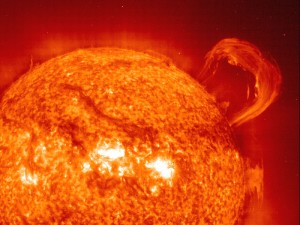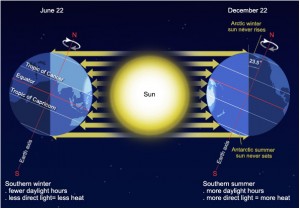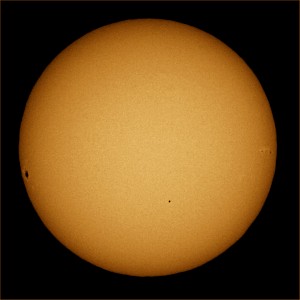The Sun, Temperature and Humidity
 We all know that the sun warms the planet and everything on it during the day and disappears at night. The earth rotates once a day while the sun pretty much stays where it is. So from our fixed location on the ground, we watch the sun rise on one side (the east), pass overhead, and then go down again on the other side (the west). Watch the video below of the earth rotating on it’s axis and also moving around the sun. The earth does a complete rotation on it’s axis once a day, and does a complete orbit of the sun once a year.
We all know that the sun warms the planet and everything on it during the day and disappears at night. The earth rotates once a day while the sun pretty much stays where it is. So from our fixed location on the ground, we watch the sun rise on one side (the east), pass overhead, and then go down again on the other side (the west). Watch the video below of the earth rotating on it’s axis and also moving around the sun. The earth does a complete rotation on it’s axis once a day, and does a complete orbit of the sun once a year.
The Seasons
Check out the video below, which is an animation showing how the earth orbits the sun:
You may notice that the axis around which the earth rotates is tilted a little with respect to the sun. Probably due to some collisions with other large objects in the solar system when the earth was forming, the axis running from the north pole to the south pole is tilted by an angle of 23.5°. This axis stays the same as the earth rotates around the sun. This means that on one side of the orbit, the northern hemisphere is leaning towards the sun, and on the other side the southern hemisphere is leaning towards the sun. This is why we have seasons.
Look at the figure to the right (you can click on the image to enlarge it). During the southern summer, the southern part of the earth (the southern hemisphere) is leaning towards the sun (right hand side of the figure). This means that the sun’s rays are more direct or more head-on in the southern hemisphere. If you were outside at midday in the summer, you would see that the sun is very high in the sky overhead. During the southern winter, things are reversed. In winter, the sun’s rays are less direct, having to go far round the earth to get to Australia (left hand side of figure). If you were outside at midday in the winter, the sun would be much lower in the sky; sort of like it is in the late afternoon in summer. In summer the days are much longer than in the winter because the part of the earth facing the sun stays in the light for much longer.
Humidity and the green-house effect
When the sun disappears over the horizon at night, the temperature drops. The atmosphere however, acts like a blanket and keeps the earth warm, even when the sun is gone. The thicker the atmosphere, the thicker the “blanket”, and the warmer the earth stays at night. The presence of water vapour (steam) in the air makes the atmosphere thicker. This is called humidity.
On the coast in the north of Australia, or close to the equator, it gets very humid. This is because the warmer oceans closer to the equator evaporate more, and put more water vapour into the atmosphere. We can get very high daily rainfall, and more humidity. The water vapour in the air keeps the earth warm at night, and the temperature does not drop nearly as much. These regions are called the “tropics”.
Humidity in the air (water vapour), as well as other gases, helps to prevent heat being lost from the earth and disappearing into space. So some of the heat coming from the sun’s rays is “trapped” and the earth is kept warm. This is called the “green-house” effect and is essential for our survival on earth. However, if the atmosphere get’s so thick, that the amount of heating of the earth by rays from the sun is greater than the amount of heat lost into space through the atmosphere, then over time, the earth will get hotter and hotter. This is the “anomalous green-house effect” and is the cause of global warming. Carbon Dioxide (CO2) in the atmosphere has a similar effect to water vapour, making the “atmospheric blanket” thicker and keeping the earth warm. This is why governments are trying to control the amount of CO2 which is released into the atmosphere by the burning of coal and oil.
However, if we didn’t have the atmosphere at all to keep us warm at night, things would get very very cold indeed. Did you know: that the surface of the planet Mercury drops to -170°C at night, just because Mercury has almost no atmosphere! And Mercury is much closer to the sun than the earth. The temperature on Mercury during the day is over 400°C!!







